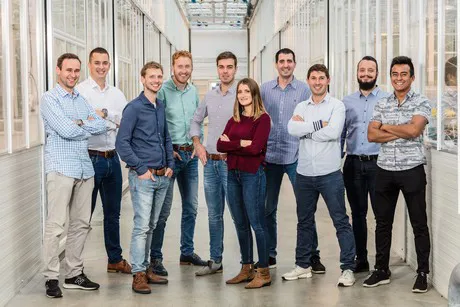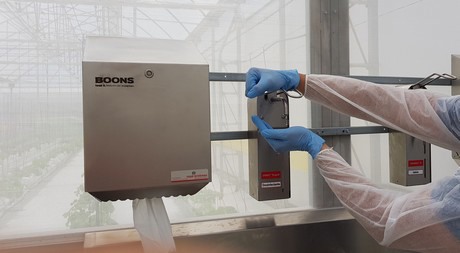This spring there were already rumors and now, at the start of the Spanish season, it has been confirmed: in Spain too they are dealing with the contagious Tomato brown rugose fruit virus (ToBRFV). "This is going to change cultivation," says Erik de Smalen of Royal Brinkman España.
In recent years, the company has developed an extensive hygiene concept under the name HortiHygienz and is now also being used by Spanish growers to step up overall hygiene measures in the fight against the virus.
“We are convinced that the sector can protect itself against this virus, but there will have to be quite a change in the approach. Otherwise the virus will appear in all nurseries in no time at all. If the Spanish tomato growers do not take prevention seriously, the cultivation can be seriously endangered or simply be lost, with all its consequences.”
The ToBRF virus is harmless to humans and animals, but can cause serious damage to crops. The ToBRF virus is highly contagious and can be transmitted easily. According to sources, since the first appearance of the virus it has already been detected in Israel, Jordan, Greece, Turkey, China, Mexico, California, Germany, United Kingdom, Italy and the Netherlands. The EPPO Global Database keeps a database with internationally confirmed finds per country. EPPO stands for European and Mediterranean Plant Protection Organization (EPPO).
The team of hygiene specialists from Royal Brinkman with the Spanish specialist Celia Martinez in the middle
Consequences for the Spanish market
It was stated last week that the virus was also found in Spain - something that everything pointed to since the spring. “The symptoms are very similar to Pepino Mosaic virus (PepMV). In the spring we saw many nurseries where the Pepino Mosaic behaved very aggressive and so it could have been Rugose, but then it was towards the end of the cultivation, the head has been removed and nobody is going to invest in analysis anymore," says Erik de Smalen from Royal Brinkman.
However, the company has already directly anticipated this. “In May we held an information meeting together with IFAPA. So many people were interested that we had to expand the room. It was packed with over 200 growers, but also with suppliers and crop advisors."
This attendance does not surprise him. “There has been almost 10,000 hectares of tomato cultivation in Almería. That has declined in recent years, but it is still a huge area. If the ToBRFV virus attacks here, what will happen then?"
He reveals the answer himself: The outbreak is very likely to have major consequences for the Spanish market. “The tomato sector is not in the best shape anyway. The acreage of tomatoes has already decreased considerably. On the one hand due to pressure from Tuta Absoluta, a persistent problem and on the other hand due to competition from Morocco. Price formation is disappointing, so growers have few means to invest. The vast majority of Spanish growers cultivate tomatoes in the soil. That is a disadvantage, because once the virus is in the soil, it is even more difficult to remove, compared to growing on substrate."
“In Spain the danger of this virus is not yet fully recognized, they have learned that they can continue to grow with Tuta if they keep the pests under control. But this is different, ToBRFV is very persistent. Very little virus material is needed to cause an outbreak."
He continues: “Although the symptoms resemble PepMV, ToBRFV is a lot harder to get rid of. With PepMV in the hot summer, when the cultivation has ended, you can disinfect well and pull the solarisacion (foil) over the ground. After that the new cultivation starts and if there are leftovers of the PepMV virus, by the time it gets really bad, it is already time again for the next cultivation.
"In short, PepMV can be tolerated and a vaccine is available if needed. Both do not apply to ToBRFV. This virus can spread more rapidly in the crop and the plant eventually dies completely. Virus particles can survive for a long time and even after years and in case of mechanical contact still can infect plants.”
What the growers/sector can (and should) do
Since the outbreak in Spain was officially announced last week, the telephone at the Spanish division of Royal Brinkman has been ringing off the hook. "Previously, companies still wanted to ignore this, but now everyone is in a high state of readiness," says Erik.
The Royal Brinkman team advises on this matter and follows their own developed HortiHygienz concept, in which application and resources come together for a best-suited, customized solution for each individual company. This has been developed in recent years to help growers with hygiene issues at their companies.
It was not easy to also focus on ToBRFV. “In the first place because it was difficult to obtain material for research, but also because of the persistence of the virus and the many opportunities of mechanical transfer in the crop. Now we have the complete picture," says Erik.
Although ToBRFV is a serious virus for which resistance is yet lacking and prevention is key, Erik is convinced that growers who do not yet have the virus in their greenhouse can arm themselves against it. “Good access control with disinfection mats or locks and Menno Florades, a Plant Protection Product that has proven to be effective. The product is stable, which means that the product, thanks to a long efficacy, can affect the virus particle well without affecting materials. Rough and rusted surfaces are difficult to clean and disinfect, this was also shown in the research.
"We also know that, thanks to the foam application, the product has a much better effectiveness; it seeps into holes and cracks and the foam makes the surface, that has not been treated, clearly visible.
"The second question is then: do you really treat everything? Even in the Netherlands, where almost everyone grows on gutters and everything is clearly in order, you can skip a small corner where some material remains. You reckon you have disinfected the entire greenhouse and then the virus still comes back. Therefore, to combat this complicated virus, you will have to apply a complete concept. Royal Brinkman has a team of ten hygiene specialists who advise growers worldwide with this HortiHygienz hygiene concept. They work together to exchange knowledge from all of these countries in order to provide a practical solution at every level."
Because that remains the most important: Prevention, prevention, prevention; the magic word in periods with high virus pressure. “Don't just let anyone enter the greenhouse anymore. If someone enters a Dutch greenhouse, they will always receive guest clothes, have their hands washed with good soap, and their hands and footwear will be disinfected. That is not yet a common practice. Yet this practice is essential to keep the virus under control. If you want to keep on growing tomatoes, a different approach is really necessary. Otherwise, it will be in every nursery in no time at all."
Packaging is a big problem
In Spain, the crate is one of the biggest problems. Erik: “The crate goes from the grower to the cooperatives and packaging stations and is emptied. The crate is not disinfected and goes back to a different nursery. You do not know which route the crate takes after being on an infected nursery."
A washer for crates can solve that problem, but growers have earned little in recent years. Yet they can also reduce risks in simple ways. “Buy an old shipping container, a steam boiler and make sure you first disinfect the pallets before they go into the growing area. And take a foam gun and immerse all crates completely in the foam with a solution of 4% Menno Florades.
Moreover, Erik thinks, it is also up to the packaging stations and cooperatives to consciously handle the crate and to wash and disinfect them, but growers themselves must also make known risky batches of crates so that they can be handled properly. “This means that more crates are needed. Dirty crates cannot be sent directly to the grower. Certainly with this virus pressure that is too great a risk. It costs money and it is extra work, but a virus outbreak is much more costly."
For more information: 
Royal Brinkman
info@royalbrinkman.nl
www.royalbrinkman.nl
Erik de Smalen
smalen@royalbrinkman.es
